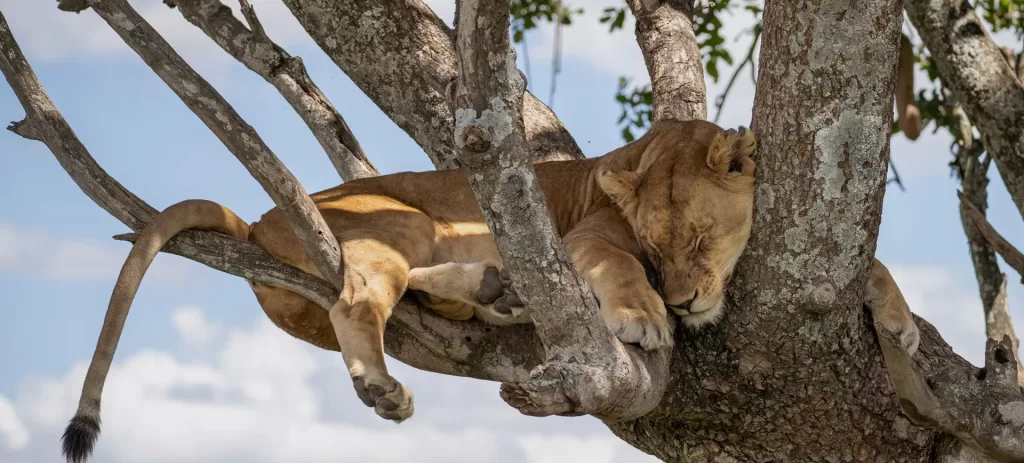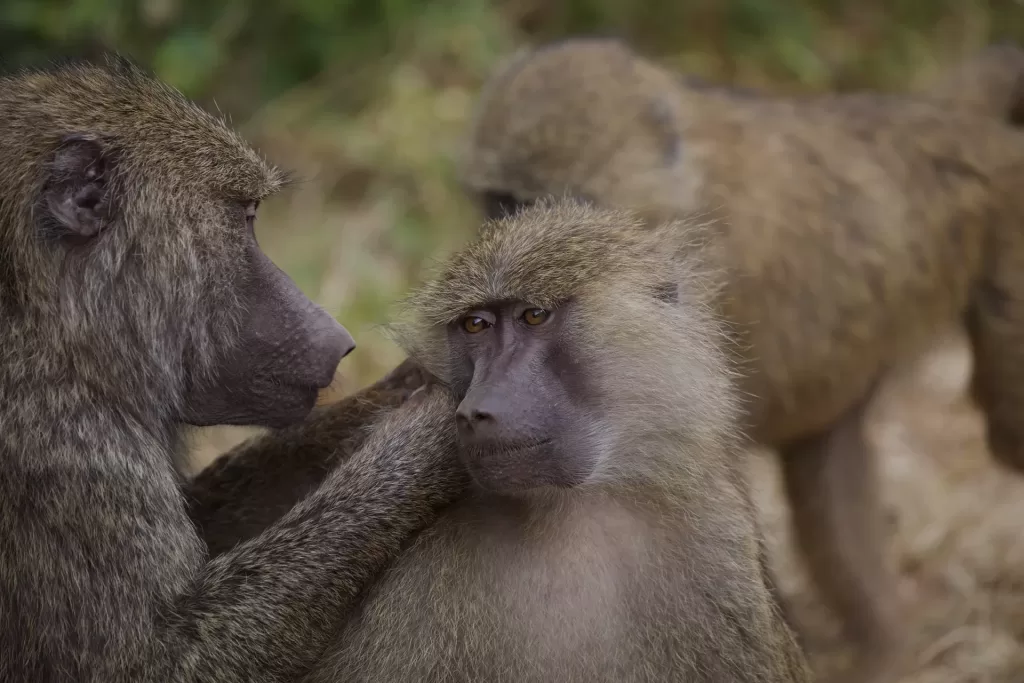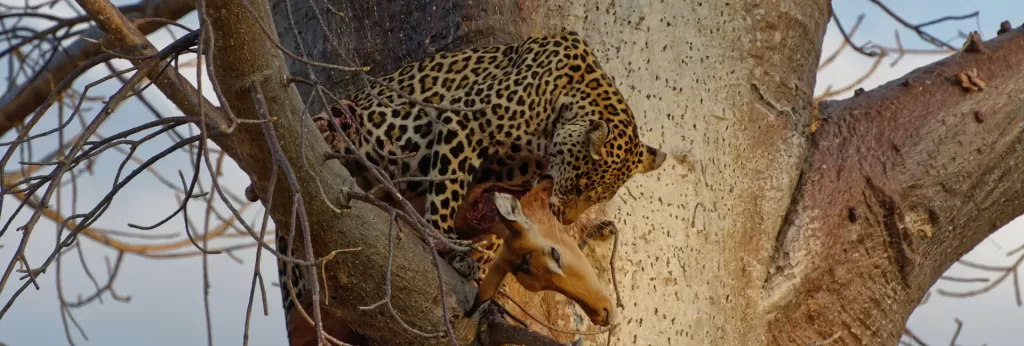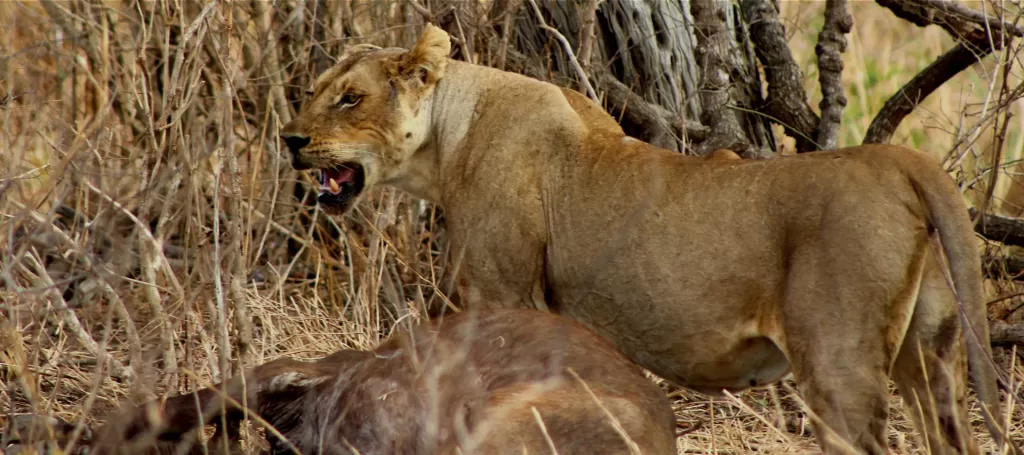Serengeti National Park
Serengeti National Park – Cycle of Life (The Great Migration)
The Serengeti National Park stands as a beacon of natural wonder, designated both as a UNESCO World Heritage site and one of Africa’s Seven Natural Wonders. Drawing adventurers and wildlife enthusiasts from across the globe, it reigns as a must-visit destination in East Africa.
Encompassing a sprawling 14,763 km², it holds the title of Tanzania’s largest and oldest national park. Its landscape is a mosaic of diverse habitats, from acacia savannahs in the central regions to grassland plains in the south and east, alongside hilly woodlands in the north, extensive forests in the west, and iconic rocky outcrops known as kopjes.
Known as ‘Siringet’ by the Maasai people, meaning ‘wide endless plains’, the park is synonymous with the awe-inspiring spectacle of The Great Migration, a breathtaking testament to the circle of life.
The Serengeti National Park annual phenomenon sees vast herds of wildebeest journeying across the Serengeti National Park in search of greener pastures, an unparalleled wildlife experience that defines the essence of the park.
Beyond the migration, Serengeti National Park teems with wildlife year-round, offering one of Africa’s premier safari experiences. From majestic elephants and imposing buffaloes to graceful gazelles and elusive leopards, the park is a haven for a diverse array of species.
The Serengeti ecosystem extends beyond the park boundaries, encompassing neighboring reserves and conservation areas such as Maswa Game Reserve to the south, Grumeti and Ikorongo Game Reserves to the east, the Maasai Mara National Reserve in Kenya to the north, and the Loliondo Game Controlled Area to the west.
During the rainy months from January to March, the wildebeest congregate in the southern Serengeti National Park and the western Ngorongoro Conservation Area before embarking on their epic migration northwestward in April, crossing the Grumeti River between late May and early July. By August, they traverse into the Masai Mara before returning southwards in November, heralding the cycle anew.
For bird enthusiasts, Serengeti National Park offers a paradise with over 530 recorded species, a quarter of which undertake annual migrations through or into the park, adding yet another layer of richness to its unparalleled biodiversity.
Things to do in Serengeti National Park
Witness the Great Migration
The great migration is a sight to behold, .this is the world’s largest wildebeest migration as it involves more than one million wildebeest, zebras, and gazelles.
For the Great Migration, you can see the herds moving into the Western Corridor from May to July, however, the main event of the Mara River crossing happens in July and August, and again in October or November, when the rainy season begins.
Visit the Seronera River Valley
This vast valley in the Central Serengeti has an abundance of wildlife. The River keeps the vegetation plentiful hence supporting herbivores throughout the year. Wildebeest, zebras, elephants, giraffes, gazelles, and many other species can be spotted.
A large amount of prey also draws the highest population of predators. The golden grassland rustles with the movement of roaming lions, cheetahs, and hyenas. This is also one of the best places to find the park’s elusive leopards.
Serengeti Safari Hot Air Balloons
Serengeti is quite large and exploring the place by foot is impossible. The Hot Air Balloons are done at dawn and you’ll be able to view the sunrise across the peninsula taking in the sights of animals.
The balloon has a capacity of 8- 12- and 16-passenger and takes people across Central Serengeti and seasonally through the Western Corridor and Southern Serengeti) to give them a bird’s-eye view of the park.
The session lasts about an hour, after which passengers gather, surrounded by the park’s lush plains, for a sparkling wine toast and an “Out of Africa” English-style breakfast.
Visit the Lobo Valley
The Lobo Valley is the best place to spot lions and other big cats in the Serengeti. The big cats are attracted to the valley because of abundant prey and permanent waterholes.
Apart from the big cats, the Lobo Valley also attracts baboons, elephants, and giraffes. Between July and November, the valley is the center of the great migration. Tourists flock to the valley to observe zebras, wildebeest, and gazelles enjoying the lush green grass in the area.
Visit the Olduvai Gorge
Situated amid Serengeti National Park and the Ngorongoro Crater, Olduvai Gorge is famous for being the site where 2 million-year-old human fossils were found. It is a top tourist spot in Serengeti that allows history buffs to dig out more about the past. Visit the Oldupai Museum which showcases the facts about fossils.
Visit the Bologonja Springs
The Northern Serengeti – Bologonja Springs downstream to the Larelemangi salt lick is great for wildlife viewing – like elephants and giraffes, as well as a variety of birds and antelope species. Bologonja Springs is a hotspot for animals and the perfect bird-watching spot. The verdant Bologonja Springs attracts hundreds of animals with refreshing waters and verdant canopies.
Walking Safaris in the Moro Kopjes and Kogatende Regions
Serengeti is home to Moru Kopjes which gives travelers a choice to explore this famous place in Tanzania. Moru Kopjes is an incredibly interesting rock formation that will thrill the adventurer in you.
These mound-like rocks rise like mountains and serve as shelters for the animals. This is an ideal spot in Serengeti for animal viewing as it has animals such as lions, cheetahs, leopards, and the famous black rhinos. They are covered with vegetation, small pools, and shade.
This is where lions and other predators go to rest as they look out for prey. The Moru Kopjes are the most popular and impressive within the Serengeti National Park.
They also contain old Masai paintings. From the top of the Kopjes, you can scan the horizon with your binoculars and get beautiful views of wildlife in the plains. The Moru Kopjes are the best place to spot black Rhinos.
Bird Watching
The Serengeti National Park is a great birding site. It is home to 542 recorded species of birds of which 11 are endemic to the Serengeti. The endemic bird species include grey-throated spurfowl, Schalow’s wheatear, red-throated tit, rufous-tailed weaver, grey-crested helmet shrike, and Schalow’s turaco.
There are also migratory birds that visit the park between November and April. They come from Europe and North Africa. The species to look out for are the great African Ostrich, vultures, Black-headed Heron, D’Arnaud’s barbet, Dark Chanting Goshawk, and Decken-Toko Tockus.
Other bird species include Grey-breasted spurfowl, Grey-headed sparrow, Purple Grenadier, Red-backed scrub, Rufous-tailed weaver, Secretary birds, The Kori bustard, Variable Sunbird, White-bellied go-away bird, White-crowned shrike, and Yellow-throated sandgrouse.
Night Time Game Drive
A night game drive in Serengeti National Park usually takes place in the Ikoma area which has several animals coming around. These night game drives in Serengeti National Park last about 2-3 hours, usually starting at 8 pm up until 11 pm. Travelers get an opportunity to see leopards, lions, civets, bush babies, genets, prickly porcupines, and nightjars.
The Retina Hippo Pool
The pool is found in the Seronera sector of the park and attracts hundreds of hippos. The pool offers you a chance to observe Hippos and Buffaloes and take great photos. Explore the pool on foot as you watch the hippos fight for the best spots, thereafter take lunch at the picnic area.
Explore the Serengeti Visitor Center
If you want to know more about Serengeti National Park, then the visitor center would be a perfect place that will give you more detailed information about the place.
The center features a walking path for self-guided walks where exhibits and detailed signs educate on Serengeti’s history, its wildlife, and the ecosystem.
Community-Based Tours
Experience Maasai culture and lifestyle
Explore the vibrant culture of the Maasai tribe within the Serengeti, where ancient traditions come alive. Visit a Maasai village to immerse yourself in their traditional lifestyle, customs, and connection to nature.
Engage with the Maasai community to learn about their rituals, customs, and way of life. Experience firsthand the hospitality of their homesteads and gain insight into their cultural beliefs. Discover their exquisite handicrafts crafted using time-honored techniques.
The Maasai, renowned as semi-nomadic pastoralists, inhabit vast regions of Southern Kenya and Northern Tanzania. Recognized for their towering stature and resplendent attire, they have resided in or near the Serengeti plains for centuries, tracing their origins back to Sudan.
Embrace the opportunity to witness traditional dance performances, further enriching your understanding of this iconic East African tribal group.
Where to stay in the Serengeti Park
Serengeti Kuhama Camp
Located in the heart of central Serengeti’s prime game viewing area, Kuhama Camp sits 29 kilometers southwest of Seronera airstrip.
Positioned on the lower slopes of Makoma Hill, the camp boasts only 10 guest tents, each offering panoramic views of the Serengeti National Park savannah.
Crafted with comfort in mind, the tents feature wooden floors and beds made from exquisite tropical wood, accompanied by bedside tables. En-suite washroom facilities, including a hand washbasin, safari bucket shower, and flush toilet, are discretely located at the far end of each guest tent.
Step onto the verandah of your tent, furnished with two safari chairs and a table, and immerse yourself in the diverse scents, sights, and sounds of the surrounding landscape. As an eco-friendly retreat, Kuhama Camp operates entirely on solar energy.
Guests can gather in the spacious and well-ventilated dining area, equipped with a standard restaurant, or relax in the intimate lounge area, complete with charging units. Complimentary Wi-Fi is available in the dining and lounge areas.
In the evenings, guests can socialize around the inviting campfire, creating unforgettable memories amidst the Serengeti wilderness.
Serengeti Sopa Lodge
Located amidst the picturesque Nyaruboro Hills in the southwest corner of the park, The Lodge offers breathtaking views of the Serengeti plains dotted with rocky outcrops, just a short 45-minute drive from Seronera airstrip.
With 65 rooms adorned with locally sourced fabrics and artwork, each accommodation boasts a cozy lounge area and mini-bar, along with an ensuite bathroom. The highlight is the verandah, offering a dramatic vista of the wildlife-rich plains below.
For a more indulgent experience, the lodge features 5 double-story suites. These luxurious suites comprise a ground-floor lounge, an upstairs bedroom with a king-size bed elevated on a wooden platform, a bathtub overlooking the plains, and an outdoor shower.
The lodge’s amenities include a spacious open dining area, a well-positioned bar area providing uninterrupted views of the Serengeti, and a terrace furnished with comfortable seating. Guests can also enjoy a refreshing dip in the swimming pool or browse the offerings at the gift shop.
Kubu Kubu Tented Camp
The Kubu Kubu Tented Camp sits nestled in the heart of the central Serengeti, benefiting from the perpetual flow of the Seronera River, which sustains local wildlife throughout the year.
Featuring 25 generously appointed double tents, each offering either a spacious king-size bed or twin beds, guests can indulge in comfort. Each tent boasts modern en-suite facilities, including a flush toilet, hand basin, and hot water shower, ensuring a luxurious stay. Illuminated by solar power, with a reliable backup generator, guests can rest assured of uninterrupted comfort during their stay.
The camp’s central building houses a welcoming lounge and restaurant, providing a cozy retreat after a day of exploration. For those seeking relaxation, a refreshing swimming pool awaits, while connectivity is maintained with Wi-Fi access. Additionally, a small library and an assortment of board games offer leisurely pursuits.
For a touch of exclusivity, breakfasts and cocktails can be arranged in secluded areas within the park upon request, adding a memorable dimension to the safari experience.
The best time to visit Serengeti National Park
The Serengeti National Park offers prime visiting times from January to February and from June to October. Nevertheless, the park’s abundant wildlife ensures an extraordinary safari adventure year-round.
Its vast plains and temperate climate ensure that vegetation never obstructs animal sightings, and the park’s two brief rainy seasons from November to December and March to April are seldom overly unpleasant.
In January, Serengeti National Park’s expansive plains are lush with greenery, providing excellent game viewing opportunities. The Ndutu Plains are particularly popular during this time, boasting a verdant landscape inhabited by year-round resident wildlife such as elephants, giraffes, and various antelope species.
February marks the wildebeest calving season, making it an ideal time for witnessing this natural phenomenon during a Serengeti safari. Thousands of wildebeest, zebras, and gazelles migrate through the park, creating a mesmerizing spectacle.
March to April signals the onset of the “long rains” season, resulting in fewer safari crowds as migratory herds begin their journey westward from the Ndutu region in the south. While humidity levels rise during this period, it also presents an opportunity for favorable accommodation rates.
July to September stands out as the peak season for witnessing the Great Migration. Spectacular river crossings occur during these months, attracting numerous tourists to the park.
August, in particular, is renowned as the pinnacle of the migration, offering unparalleled opportunities to witness the dramatic crossings from the northern Serengeti National Park into the Masai Mara.
How to get to Serengeti National Park
Arusha to Serengeti National Park is about 7- 8 hours. There are regional flights from Arusha or Kilimanjaro to the park that take 1-2 hrs flight to any seven of the airstrips of the park. All these flights are operated by Coastal Aviation or Grumeti Air.
Safari Destinations in Tanzania
ABOUT TRAVELERS LINK AFRICA
Our mission at Travelers Link Africa is to connect people to positive travel experiences enabling them to see the world differently, transforming lives and the communities visited.
To do this we offer authentic travel experiences taking you on both an outer adventure and an inner journey to create memories of a lifetime with Uganda, Kenya, Tanzania, and Rwanda
CONNECT WITH US
We’re here to help, so get in touch with our friendly travel consultants to book your package or add customizations your safari
Our main phone number is
+256 754 062 366
– OR –






